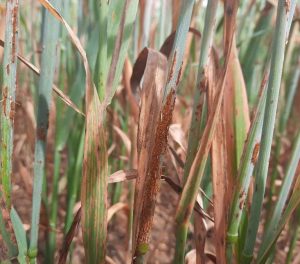Stem rust in oats is caused by fungus Puccinia graminis var. avenae. Stem rust is found across oat growing regions of Victoria. It can be a damaging disease that can cause significant yield losses in susceptible cultivars.
What to look for
Stem rust can infect leaves, leaf sheaths, stems, and panicles. Stem rust produces reddish-brown, powdery, oblong pustules with a characteristic torn margin that can occur on both sides of the leaves, on the stems and the glumes. Stem rust spores are much darker in colour than Crown rust spores, which are light brown and don’t have torn margins.
Disease Cycle
Like other rusts of cereals, Stem rust requires living hosts to grow and reproduce. It survives on volunteer and/or wild oats during summer and builds the inoculum for the next season. Spores are readily dispersed by wind and travel long distances. Stem rust usually develops at higher temperatures than Crown rust at temperatures of 18 to 30°C, and is therefore more problematic for in longer season, high rainfall environments. The latent period of Stem rust is relatively short and can produce new spores within 7-10 days following infection.
Economic Importance
Stem rust can cause yield losses of 50 per cent in both hay and milling oat crops and can cause total crop failure when susceptible cultivars grown under favorable conditions.
Management
Cultural Control
Control measures for Stem rust are very similar to Crown rust. Pre-season management including control of volunteers and wild oats is critical for reducing inoculum levels and carry over to the next season. Stem rust requires slightly warmer temperatures and develops late in the season meaning that most crops escape serious infection.
Variety Resistance
Cultivation of resistant cultivars is highly recommended where crops are at risk of losses. See a current Cereal Disease Guide for up-to-date ratings. Where susceptible varieties are at risk, fungicide application soon after the detection of rust pustules will reduce losses in susceptible varieties.
Stem rust can develop new pathotypes which can change a variety’s reaction. Current pathotypes are monitored every season to ensure that resistance ratings are up to date. The Australian Cereal Rust Control Program, based at the University of Sydney and supported by GRDC, conducts annual monitoring of Stem rust pathotypes present in Australia. The information on the pathotypes is crucial in determining how varieties will perform to the dominant rusts present in Australia. For details on how to submit Stem rust samples for pathotyping and to view pathotyping results see the Further Information section.
Fungicides
It is important that growers follow all label directions including rates, crop growth stages and withholding periods to grazing, cutting for forage/hay and harvest to ensure that maximum residue limits are not exceeded in destination markets.
DO NOT apply more than 2 applications of any product(s) from the same mode of action group in any one season. If additional applications are required during periods of high disease pressure, then growers need to switch to alternative products with differing modes of action. To reduce the risk of fungicide resistance development. See Fungicides for further information about fungicide resistance.



